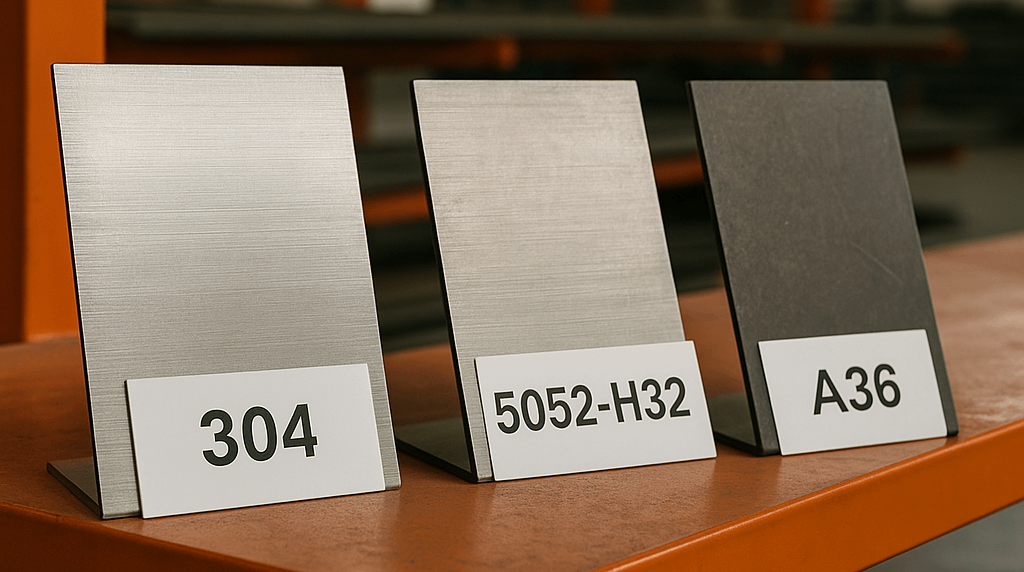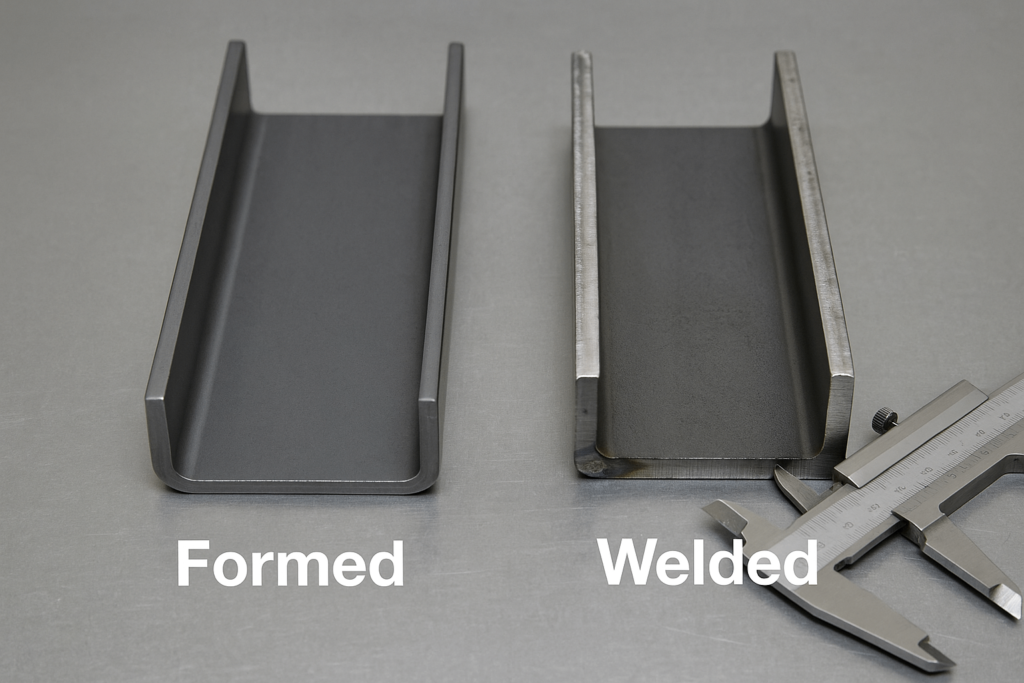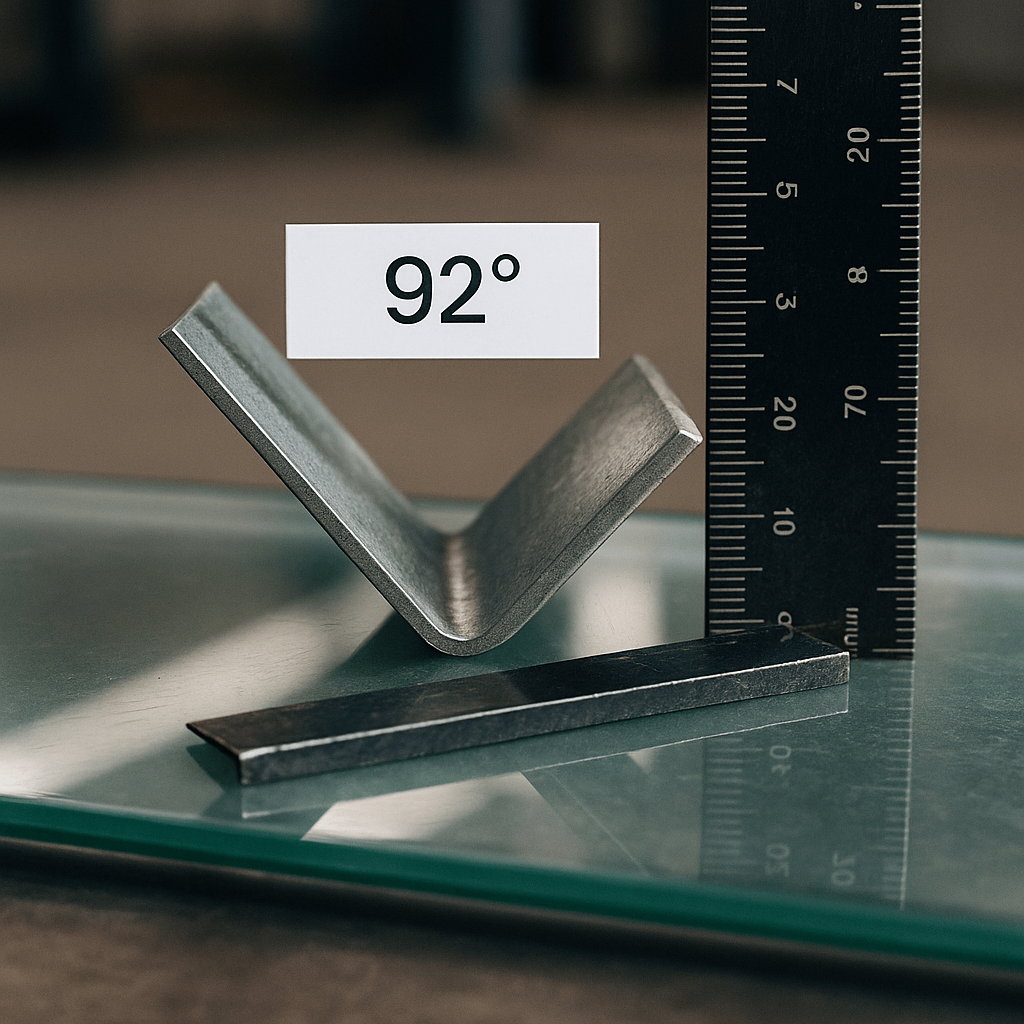The Silent Cost of a "Simple" Bend
Imagine a multi-million dollar automation project, months in the making, suddenly halted during final testing. The culprit isn’t a complex sensor, but a single U-shaped steel bracket that has fractured at its bend.
This scenario is common—and avoidable. The risk doesn’t come from the part being “simple,” but from invisible design risk created by small decisions with big consequences.
Top 3 high-impact mistakes:
Inside radius R < thickness T → micro‑cracks and fatigue failures (see Part 2: Bend Radius).
Bending with the grain → higher crack probability vs. across‑grain (see Part 5: Scenario 2).
Holes in the deformation zone (< 2T + R) → teardrops, misfit, scrap (see Part 2: Feature Placement).
This article offers a decision framework to avoid those traps in U‑channel design—built for engineers and procurement teams accountable for cost, quality, and lead time. By the end, you’ll have a practical method to control total cost of ownership (TCO) and turn risk into reliable, profitable production.
Part 1: The Foundation - The Manufacturability Triangle: Your Strategic Compass
Introducing a New Way of Thinking: The Cost, Performance, & Manufacturability Framework
To master U-shaped sheet metal design, we must first establish a logic that governs every decision. Forget isolated rules and embrace a holistic model: The Design Trinity, or the Manufacturability Triangle.
This framework posits that every successful design is a deliberate balance between three competing cornerstones: Cost, Performance, and Manufacturability.
Performance: This is the “what” of your design. It encompasses all functional requirements: load-bearing capacity, resistance to fatigue and corrosion, and dimensional precision. Pushing for maximum performance can affect field reliability and warranty costs.
Cost: This is the economic reality. It includes raw material, labor, machine time, tooling, and potential scrap. Understanding this is key to value engineering and managing the total cost of ownership (TCO), not just the unit price.
Manufacturability: This is the “how.” How easily, reliably, and quickly can your part be produced? High manufacturability leads to higher yields, predictable lead times, and greater consistency—a cornerstone of a reliable supply chain.
These three pillars are in a constant state of tension. Optimizing for one will invariably influence the others.
Turn rhetoric into rules — a mini decision map:
| Design Lever | Cost Impact | Performance Effect | Manufacturability Signal | Practical Note |
|---|---|---|---|---|
| Material grade & thickness | Drives raw cost and weight | Strength/corrosion baseline | Bendability, springback | 5052 bends easier than 6061‑T6; 316 resists chlorides but costs more |
| Inside bend radius (R) | Tighter R → more scrap/rework | Too tight → fatigue risk | Match to standard punches | Aim R ≥ T; increase R for SS & 6061 |
| Feature distance to bend | Rework if inside zone | Hole distortion → assembly risk | Keep ≥ 2T + R | Add reliefs or re‑sequence ops if space constrained |
| Formed vs welded | Weld adds labor/fixtures | HAZ may reduce fatigue life | Forming faster in volume | Weld only when geometry demands |
| Tolerance scheme | Tight = higher processing/inspection | Ensures fit where needed | Use ISO 2768‑m globally | Call out local tight tol for critical features |
Strategic takeaway: Define your priority (Cost / Performance / Manufacturability) per project, then configure each lever accordingly.
Part 2: The Application - Navigating Key Design Decisions with the Triangle Framework
Before RFQ, lock four variables that drive both price and feasibility: alloy & temper, exact thickness, minimum inside radius, feature‑to‑bend distance. Each maps directly to Cost/Performance/Manufacturability. Each decision below turns abstract trade‑offs into profitable practice.
Decision Point #1: Material Selection - Beyond the Spec Sheet
Choosing a material is far more than matching a callout on a spec sheet; it is the first and most fundamental balancing act in our framework. The choice directly dictates the baseline for performance and cost, while heavily influencing manufacturability.
When evaluating how to choose material for sheet metal, your decision should be a strategic one, informed by the end-use application and total project budget.
Calibrating for Performance vs. Cost:
Mild Carbon Steel (A36, 1018): Cost baseline; easy to cut/weld/bend. Press brake note: typical V‑die opening ≈ 6–10×T works well; coatings (powder/zinc) handle corrosion. Use for: general brackets, high‑volume parts with secondary finishing.
Stainless (304, 316): High corrosion resistance; higher forming force and springback; greater tool wear. 304 suits indoor/standard environments; 316 for chlorides/marine. Process note: expect larger over‑bend and tighter QC of angles.
Aluminum (5052, 6061): Lightweight, naturally corrosion‑resistant. 5052‑H32 is the default for aluminum U‑channel bending; 6061‑T6 needs larger R or form in softer temper then heat‑treat. Design note: plan R and grain orientation early.

Decision Point #2: The Bend Radius - The Epicenter of Strength and Failure
Nothing impacts strength and yield more than bend radius.
Rule of thumb: R ≥ T (increase for SS & 6061). Too tight → thinning, micro‑cracks, poor cosmetics.
Tooling alignment: Use your fabricator’s standard punch radii to avoid custom tooling cost/lead‑time.
Quick picks — recommended inside R (typical shop baselines):
| Thickness (T) | 5052‑H32 | 6061‑T6 | 304 SS |
| 1.0 mm | ≥ 1.0 mm | ≥ 1.5–2.0 mm | ≥ 1.5 mm |
| 1.5 mm | ≥ 1.5 mm | ≥ 2.0–2.5 mm | ≥ 2.0 mm |
| 2.0 mm | ≥ 2.0 mm | ≥ 3.0 mm | ≥ 2.5–3.0 mm |
Baseline only; confirm with your supplier’s tooling library.
Worked example: switching a 2.0 mm 6061‑T6 inside radius from 1.0T → 1.5T typically reduces edge cracking risk and rework, and often improves surface grade to pass cosmetic criteria—without tooling changes.
Standard vs custom tooling — when do you trigger custom?
Required inside R has no matching punch in the library
Deep U beyond press brake throat depth / V‑opening
Extremely narrow flanges that need special fingers → Expect tool cost + additional tryouts + longer lead time.
Decision Point #3: Feature Placement (Holes & Slots) - Maintaining Structural Integrity
Keep features ≥ 2T + R from the bend tangent to avoid distortion and stress risers. Teardropping and misalignment are common root causes of assembly scrap.
If space is tight, consider:
Re‑orient the blank so bends go across grain, gaining formability margin.
Operation re‑sequence: pre‑pierce pilot holes, form, then finish‑size with a secondary op.
Add corner/slot reliefs to control material flow at the bend.
Clear feature placement is a DFM win: predictable results, lower scrap, smoother assembly.
Part 3: The Critical Juncture — Formed vs. Welded U-Channel Decision Matrix
The Most Important Cost Decision You Will Make
This choice appears when channel depth/flange length exceed press‑brake limits. It impacts labor, tooling, lead time, and fatigue behavior.
Cost crossover example (illustrative):
Formed: setup amortized by volume; cycle ≈ seconds; minimal post‑process
Welded: cut + fit + weld + grind; labor‑minutes per part → At ≤ 60–80 pcs per build, welding may be comparable; beyond that, forming typically wins on unit cost and takt time (shop‑dependent). Decide with your supplier’s real rates.
| Consideration | One-Piece Formed (Press Brake) | Welded U-Channel Assembly | Recommendation |
| Structural Performance | Continuous grain flow; excellent fatigue resistance | Heat-affected zones can weaken if not controlled | Prefer forming for high-load / vibration applications |
| Manufacturing Cost (Per Unit) | Lower — fewer steps, faster cycles | Higher — cutting, fitting, welding, finishing | Forming dominates at medium–high volumes |
| Lead Time | Shorter; streamlined process | Longer; multi-step workflow | Form when deadlines are tight |
| Design Flexibility | Limited by press brake depth & tooling | Very high; extreme depths and mixed gauges | Weld only when geometry demands it |
| Aesthetic Consistency | Clean and seamless | Weld seams/distortion risk | Forming for visible/cosmetic parts |
The conclusion from this matrix is clear and actionable for any procurement professional or engineer. If your design can be modified to accommodate the limitations of press brake forming without compromising its core function, it is almost always the superior strategic choice for optimizing ROI and mitigating production risk.
It delivers a stronger, cheaper, and more consistent part, faster. A welded assembly should be reserved for situations where the design’s geometric requirements are absolute and cannot be achieved through forming. This single decision, made early in the process, can have a greater impact on the final cost and timeline than almost any other design parameter.

Part 4: The Expert's Edge — DFM Secrets for U-Channel Sheet Metal That Speak a Fabricator's Language
True design mastery extends beyond CAD; it’s about eliminating ambiguity with the shop. Clear inputs → fast quotes → stable production.
How to Submit a "Quotation-Ready" Package
Include:
STEP 3D model (clean, final geometry)
2D PDF drawing with critical dims/tolerances
Material grade + exact thickness
Finish & masking map (areas to keep bare)
Quantity & cadence / EAU
A Pre-Submission DFM Audit for Maximizing ROI
Unify bend radii where possible to reduce setups
Match standard tooling to avoid custom dies
Tolerances by function (ISO 2768‑m globally; local callouts where needed)
Remove cosmetic‑only features that add cost
Three missing items that delay quotes:
No masking/keep‑out callouts for coatings
Missing primary datum scheme (A/B/C) for inspection
No inspection plan (sample size, CTQs)
Drawing communication snippets:
FLAG NOTE 1: “DIMENSIONS MARKED ▶ ARE CRITICAL FOR ASSEMBLY; APPLY ±0.10 mm”
FINISH NOTE: “POWDER COAT RAL9005; MASK M5 THREADED HOLES & GROUND LUG”
By internalizing these DFM practices, you move from part design to manufacturing architecture—saving weeks of churn and rework.
Part 5: Real-World Problem Solving - An Interactive Troubleshooting Guide
Theory and guidelines are essential, but the real test of knowledge—and a supplier’s experience—comes when confronting real-world problems. Here are some common scenarios encountered during prototyping and production, along with expert analysis on their root causes and solutions.
Scenario 1: "My prototype part came back, and the flanges aren't 90 degrees. Why?"
This is classic springback. A 90° punch may yield 92° on release; pro shops over‑bend to land on print.
Cause: Material, thickness, and radius drive elastic recovery (SS > MS > 5052).
Solution: Springback compensation with calibrated over‑bend; verify per batch.
Verification action: Record programmed angle vs. measured result for first‑article parts; log material heat/lot for traceability.

Scenario 2: "I see small cracks near the bend on my aluminum part. What are the likely culprits?"
Too‑tight radius (R < recommended)
Bending with the grain (parallel orientation)
Alloy/temper choice (6061‑T6 formed too late)
Fixes: Increase R; rotate layout to bend across grain; form in softer temper then age.
Verification action: Make coupon bend tests (across/with grain) and microscope edge checks before full run.
Scenario 3: "How do I communicate a critical tolerance on just one dimension of my U‑channel?"
Issue: Global title‑block tolerances may be too loose for one feature.
Solution: Add local tolerance next to the critical dim (e.g., 50.00 ± 0.10 mm) and a flag note (CRITICAL FOR ASSEMBLY). Consider a go/no‑go gauge or CMM reference.
Verification action: Define a CTQ inspection step and sampling plan on the PO or print.
Frequently Asked Questions (FAQ)
Q1: What materials are best for custom U‑channel fabrication?
A: Mild steel for cost efficiency, 304/316 for corrosion, 5052/6061 for weight. For aluminum U‑channel bending, 5052‑H32 is most formable. (See Part 2.)
Q2: How do I ensure my design fits standard press brake tooling for U channels?
A: Align inside R with standard punches; share STEP + PDF in RFQ for DFM review. (See Part 2: Bend Radius.)
Q3: What tolerances are realistic for sheet metal U‑channels?
A: Use ISO 2768‑m globally; apply local ±0.10 mm on assembly‑critical features. (See Part 4.)
Q4: How far from the bend should holes or slots be placed?
A: Respect 2T + R from feature edge to bend tangent; add reliefs or re‑sequence if tight. (See Part 2: Feature Placement.)
Q5: Formed or welded—how do I choose?
A: Form when geometry allows (stronger/faster/cheaper in volume); weld for extreme depths or mixed gauges. (See Part 3.)
Q6: Typical lead times for prototypes and production?
A: Prototypes in 5–7 working days for standard materials; production varies with volume and finishing.
Q7: What QA documentation can you provide?
A: Material certs (mill test), COC, dimensional inspection reports (FAI), and PPAP‑style packages on request.
Q8: Do you support gauges/fixtures for critical U‑channel dimensions?
A: Yes—simple go/no‑go gauges for flange width/height or custom fixtures for parallelism reduce inspection time and scrap.
Conclusion: From Designer to Decision‑Maker
A “simple” U‑channel succeeds when trade‑offs are explicit, not accidental. Use the triangle to set priorities, then tune material, radius, features, and forming method to match.
Go‑live checklist (keep this with your RFQ):
Unify inside R and match standard punches
Keep features ≥ 2T + R or add reliefs/re‑sequence
Specify material grade + temper + thickness
Set ISO 2768‑m globally; flag local critical dims (±0.10 mm)
Attach STEP + PDF, finish spec with masking map, and EAU
Ready to de‑risk your next build? Share your drawing for a no‑obligation DFM review—we’ll respond with actionable options that balance cost, performance, and manufacturability.

